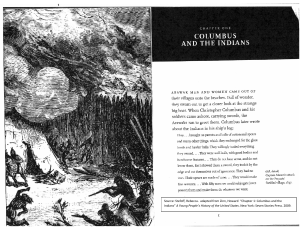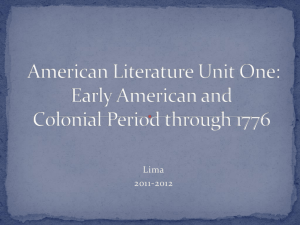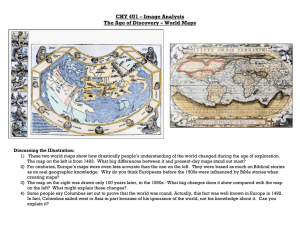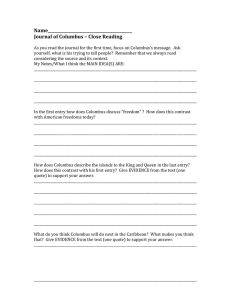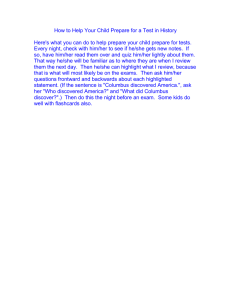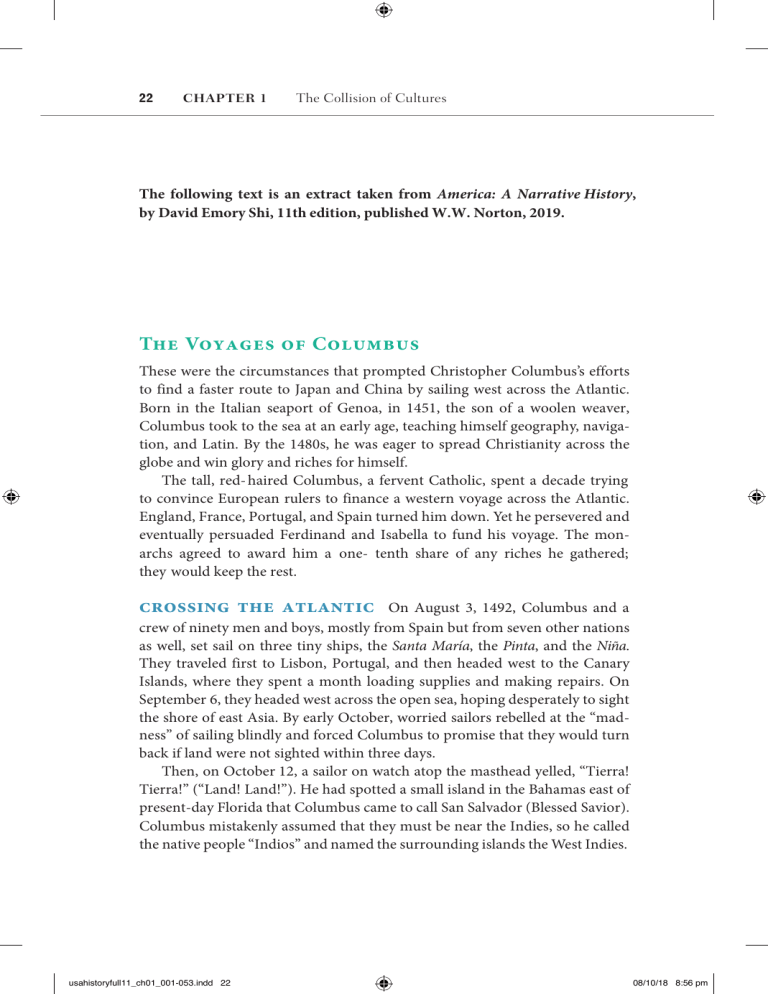
22 Chapter 1 The Collision of Cultures The following text is an extract taken from America: A Narrative History, by David Emory Shi, 11th edition, published W.W. Norton, 2019. The Voyages of Columbus These were the circumstances that prompted Christopher Columbus’s efforts to find a faster route to Japan and China by sailing west across the Atlantic. Born in the Italian seaport of Genoa, in 1451, the son of a woolen weaver, Columbus took to the sea at an early age, teaching himself geography, navigation, and Latin. By the 1480s, he was eager to spread Christianity across the globe and win glory and riches for himself. The tall, red- haired Columbus, a fervent Catholic, spent a decade trying to convince European rulers to finance a western voyage across the Atlantic. England, France, Portugal, and Spain turned him down. Yet he persevered and eventually persuaded Ferdinand and Isabella to fund his voyage. The monarchs agreed to award him a one- tenth share of any riches he gathered; they would keep the rest. crossing the atlantic On August 3, 1492, Columbus and a crew of ninety men and boys, mostly from Spain but from seven other nations as well, set sail on three tiny ships, the Santa María, the Pinta, and the Niña. They traveled first to Lisbon, Portugal, and then headed west to the Canary Islands, where they spent a month loading supplies and making repairs. On September 6, they headed west across the open sea, hoping desperately to sight the shore of east Asia. By early October, worried sailors rebelled at the “madness” of sailing blindly and forced Columbus to promise that they would turn back if land were not sighted within three days. Then, on October 12, a sailor on watch atop the masthead yelled, “Tierra! Tierra!” (“Land! Land!”). He had spotted a small island in the Bahamas east of present-day Florida that Columbus came to call San Salvador (Blessed Savior). Columbus mistakenly assumed that they must be near the Indies, so he called the native people “Indios” and named the surrounding islands the West Indies. usahistoryfull11_ch01_001-053.indd 22 08/10/18 8:56 pm European Visions of America 23 At every encounter with the peaceful native people, known as Tainos, his first question, using sign language, was whether they had gold. If they did, the Spaniards seized it; if they did not, the Europeans forced them to search for it. The Tainos, unable to understand or repel the strange visitors, offered gifts of food, water, spears, and parrots. Columbus described them as “­well-­built, with good bodies, and handsome features”—­ brown-­skinned, with straight black hair. He marveled that they could “easily be made Christians” and “would make fine servants,” boasting that “with fifty men we could subjugate them all and make them do whatever we want.” He Christopher Columbus A portrait by promised to bring six “natives” back to Sebastiano del Piombo, ca. 1519. Spain for “his highnesses.” Thus began the typical European bias toward the Indians, the belief that they were inferior peoples worthy of being exploited and enslaved. exploring the caribbean After leaving San Salvador, Columbus, excited by native stories of “rivers of gold” to the west, landed on the north shore of Cuba. He went ashore, sword in one hand, cross in the other, exclaiming that it was the “most beautiful land human eyes have ever beheld.” After a few weeks, Columbus sailed eastward to the island he named Hispaniola (“the Spanish island”), ­present-­day Haiti and the Dominican Republic. He described the island’s Indians as the “best people in the world,” full “of love and without greed.” They had no weapons, wore no clothes, and led a simple life, cultivating cassava plants to make bread but spending most of their time relaxing, “seemingly without a care in the world.” Columbus, however, had no interest in simple living. He decided that the Indians were “fitted to be ruled and be set to work” generating riches for Spain. To that end, he decreed that those over age fourteen must bring him at least a thimbleful of gold dust every three months. As it turned out, the quota was often ­unattainable—­there was not as much gold in the Caribbean as Columbus imagined. Nevertheless, those who failed to supply enough gold had their hands cut off, causing many of them to bleed to death. If they fled, usahistoryfull11_ch01_001-053.indd 23 08/10/18 8:56 pm 24 Chapter 1 The Collision of Cultures COLUMBUS’S VOYAGES ENGLAND NORTH AMERICA FRANCE PORTUGAL SPAIN AZORES AT L A N T I C GULF OF MEXICO BAHAMAS Cuba PACIFIC OCEAN ■ OCEAN San Salvador 1493 AFRICA Hispaniola Jamaica CENTRAL AMERICA CANARY ISLANDS 1492 1502 CARIBBEAN SEA LESSER ANTILLES CAPE VERDE ISLANDS 1498 Trinidad SOUTH AMERICA How many voyages did Columbus make to the Americas? WWN64 America 10e ■ What is the origin of the name for the Caribbean Sea? 26593_01map_04 ■ What First proofhappened to the colony that Columbus left on Hispaniola in 1493? war dogs hunted them down. Huge numbers died from overwork or disease; others committed suicide. Columbus, reported a Spanish priest, was so eager to please Ferdinand and Isabella “that he committed irreparable crimes against the Indians.” During fifty years of Spanish control, the Indians on Hispaniola virtually disappeared. In their place, the Spanish began importing enslaved Africans. At the end of 1492, Columbus, still convinced he had reached an outer island of Japan, sailed back to Spain, taking a dozen Tainos as gifts for the king and queen. After receiving a hero’s welcome, he promised Ferdinand and Isabella that his discoveries would provide them “as much gold as they need . . . and as many slaves as they ask.” usahistoryfull11_ch01_001-053.indd 24 08/10/18 8:56 pm European Visions of America 25 Thanks to the newly invented printing press, news of Columbus’s pathbreaking voyage spread rapidly across Europe and helped spur a restless desire to explore the world. The Spanish monarchs told Columbus to prepare for a second voyage, instructing him to “treat the Indians very well and lovingly and abstain from doing them any injury.” Columbus and his men would repeatedly defy this order. Spain worked quickly to secure its legal claim to the Western Hemisphere. With the help of the ­Spanish-­born pope, Alexander VI, Spain and Portugal signed the Treaty of Tordesillas (1494). With the stroke of a pen, it divided the n ­ on-­Christian world, giving most of the Western Hemisphere to Spain, with Africa and what would become Brazil granted to Portugal. In practice, this meant that while Spain developed its American empire in the sixteenth century, Portugal provided it with most of its enslaved African laborers. In 1493, Columbus returned to the New World, crossing the Atlantic with seventeen ships and 1,400 sailors, soldiers, and s­ettlers—­all men. Also on board were Catholic priests eager to convert the native peoples to Christianity. Upon his arrival back in Hispaniola, Columbus discovered that the forty men he had left behind had lost their senses, raping women, robbing villages, and, as his son later added, “committing a thousand excesses for which they were mortally hated by the Indians.” naming america Columbus proved to be a much better ship captain than a colonizer and a governor. His first business venture in the New World was as a slave trader. When he returned to Spain from his second voyage with hundreds of captive Indians, Queen Isabella, who detested slavery, was horrified. “Who is this Columbus who dares to give out my vassals [Indians] as slaves?” This incident set in motion a series of investigations into Columbus’s behavior. The queen sent a Spanish royal commissioner, Francis Bobadilla, to Hispaniola. The first things he saw were the corpses of six Spanish settlers hanging from a gallows; more colonists were to be hanged the next day. Bobadilla was so shocked that he canceled the executions and announced that he was supplanting Columbus as governor. When Columbus objected, Bobadilla had him jailed for two months before shipping the explorer, now nearly blind and crippled by arthritis, back to Spain in chains in 1500. To the end of his life, in 1506, Columbus insisted that he had discovered the outlying parts of Asia. By one of history’s greatest ironies, this led Europeans to name the New World not for Columbus but for another Italian ­sailor- ­explorer, Amerigo Vespucci. In 1499, with the support of Portugal’s monarchy, Vespucci sailed across the Atlantic, landing first at Brazil and then sailing along 3,000 miles of the usahistoryfull11_ch01_001-053.indd 25 08/10/18 8:56 pm 26 Chapter 1 The Collision of Cultures South American coastline in search of a passage to Asia. In the end, Vespucci decided that South America was so large and so densely populated that it must be a new continent. In 1507, a German mapmaker paid tribute to Vespucci’s navigational skills by labeling the New World using the feminine Latin variant of the explorer’s first name: America. professional explorers News of the remarkable voyages of Columbus and Vespucci stimulated other expeditions. The fi rst explorer to sight the North American continent was John Cabot, an Italian sponsored by King Henry VII of England. Cabot’s landfall in 1497 at what the king called “the new founde lande,” in present- day Canada, gave England the basis for a later claim to all of North America. On a return voyage, however, Cabot and his four ships disappeared. Their grim fate as well as the English monarchy’s preoccupation with religious strife, suppressing a massive rebellion by Irish Catholics, and conducting a war with France prevented it from following up on Cabot’s discoveries for one hundred years. The English were unaware that Norsemen (“Vikings”) from Scandinavia (Denmark, Norway, Sweden) had in fact been the first Europeans to “discover” and colonize areas of North America. As early as the tenth century, Norsemen had landed on the rocky, fogbound shore of Greenland, a huge island off the northeast coast of North America. They established farming settlements that were active for hundreds of years until prolonged cold weather forced them back to Scandinavia. usahistoryfull11_ch01_001-053.indd 26 08/10/18 8:56 pm

